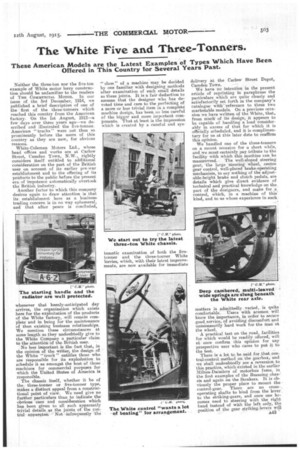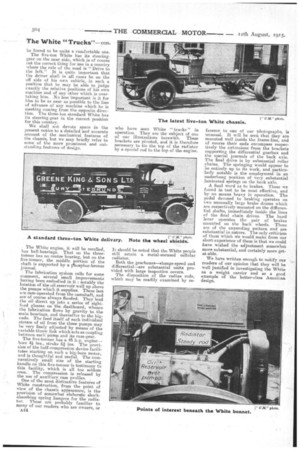The White Five and Three.Tonners,
Page 13

Page 14

If you've noticed an error in this article please click here to report it so we can fix it.
These American Models are the Latest Examples of Types Which Have Been Offered in This Country for Several Years Past.
Neither the three-ton nor the five-ton example of White motor lorry construction should be unfamiliar to the readers Of THE COMMERCIAL MOTOR. In our issue of the 3rd December, 1914, we published a brief description of one of the first of the three-tonners which reached this country from the American factory. On the 1st August, 1912—a few days over three years ago—we deseribed and illustrated the five-tonner. American "trucks' were not then so prominently before the users of this country as they are now, for obvious reasons.
White-Coleman Motors Ltd., whose head offices and works are at Carlow Street, Camden Town, N.W., rightly considers itself entitled to additional consideration on the part of the British user on account of its earlier pre-war establishment and to the offering of its products to the public before the present era of impotence automatically overtook the British industry. Another factor to which this company desires again to draw attention is that its establishment here as a business trading concern is in no way ephemeral, and that after peace is concluded, whenever that keenly-anticipated day arrives, the organization which exists here for the exploitation of the products of the White factory, will remain complete and in being for the maintenance of then existing business relationships. We mention these circumstances at some length as they undoubtedly give to the White Company a particular claim to the attention of the British user.
No less important is the fact that, in the opinion of the writer, the design of the White " truck " entitles those who are responsible for its exploitation to schedule it as amongst the best of those machines for commercial purposes for Which the United States of America is responsible.
The chassis itself, whether it be of the three-tonner or five-tonner type, makes a distinct appeal from a constructional point of view. We need give no further particulars than to indicate the obvious care and consideration which has been given to all such apparently trivial details as the joints of the con= trol apparatus. Not infrequently the " class " of a machine may be decided by one familiar with designing methods after examination of such small details as these joints. It is a fair deduction to assume that the designer who has de= voted time and care to the perfecting of a more or less trivial item in a complete machine design, has been no less careful of the bigger and more important components. That at least is the impression which is created by a careful and sys
delivery at the Carlow Street Depot, Camden Town.
We have no intention in the present article of reprinting in paraphrase the particulars which are quite clearly and satisfactorily set forth in the company's catalogue with' referenceto these two marketable models. On a previous occasion we have written of the White, that, from Much of its design, it appears to be capable of handling a load considerably in excess of that for which it is officially scheduled, and it is complimentary for us at this later date to reaffirm this opinion.
We handled one of the three-tonners on a recent occasion for a short while, and we must certainly pay tribute to the facility with which this machine can be manoeuvred. The well-sloped steering gear, the large steering wheel, centre gear control, well-placed brake-operating mechanism, to eay nothing of the adjustable-height brake and clutch pedals, are details which give direct evidence of technical and practical knowledge on the part of the designers, and make for a control, Which, in a machine of this' kind, and to us whose experience in such
matters is admittedly varied, is quite comfortable. Users with acumen will know the importance, in order to secure good service, of avoiding discomfort and unnecessarily hard work for the Man at the wheel.
A practical test on the road, facilities for which would be readily offered, will at once confirm this opinion for any prospective user who cares to put it to the test.
There is a lot to be said for that.central-control method on the gearbox, and we shall undoubtedly see a reversion .to this practice, which :existed in the earlier Milnes-Daimlers of motorbus fame, in the first examples of the I3uessing chassis and again on the Straker& It is obviously the proper place to mount the control-gear. There are no MOSS-operating shafts to bind from the lever to the striking-gears, and once one becomes used to steering with the right band instead of with the left only, the position of the gear striking-levers will
he found to be quite a comfortable one
The five-ton White has its steeringgear on the near side, which is of course not the correct thinsfor use in a country where the rule of die road is "Drive to the left." It is quite important that the driver shall in all cases be on the off side of his own vehicle,: in such a position that he may be able to judge exactly the relative positions of his own machine and of any other which is overtaking him. No less important is it for him to be as near as possibleto the line of advance of any machine which be is meeting coming from the opposite direction. The three-ton standard White has its steering-gear in the correct position for this country.
We shall not devote space in the present notice to a detailed and accurate account of the mechanical features of the chassis, but we may briefly refer to some of the more prominent and outstanding features of design.
The White engine, it will be recalled, has ball-bearings. That on the three tonner has no centre bearing, but on the five-tonner, the middle portion of. the shaft. is supported by a jahosphor-bronze journal. The lubrication system calls for some comment, several small improvements having been embodied in it : notably the location of the oil reservoir well up above the pumps which. it supplies. These last are cam-operated from the camshaft, and are of course always flooded. They lead the oil direct up into a series of sight feed glasses on the, dashboard, whence the lubrication flows by gravity to the main bearings, and thereafter to the big ends. The feed itself of each individual stream of oil from the three pumps may be very finely adjusted by means of the variable-throw link which acts as coupling between each purap and its cam-gear. The five-tonner has a 45 li.p. engine— bore 4,1 ins., stroke 61 ins. The provi sion of the half-compression device facili tates starting on such a big-bore motor, and is thoughtful and useful. The com
paratively smell size of the starting handle on this five-tonner is testimony to this facility, which is all too seldom seen.The compression is released by the use of auxiliary cam profiles. .
One of the most distinctive features of White construction, from the point of view of the chassis appearance, is the provision of somewhat elaborate shockabsorbing spring 'hangers for the radiator. These are probably familiar to many of our readers who are owners, or A44 who have seen White " trucks " in operation. They are the subject of one of our illustrations herewith. These brackets are pivoted, and it is therefore necessary to tie the top of the radiator by a special rod to the top of the engine.
It should be noted that the White people still retain a metal-encased cellular radiator.
Both the gearboxes—shange-speed and differential—are substantial units prov ded with large inspection covers.
The disposition of the radius rods, which may be readily examined by re ference to one of our photographs, is unusual. It will be seen that they are mounted well inside the frame-line, and of course their ends encompass respectively the extensions from the brackets sup-porting the differential gearbox and the special journals of the back axle. The final drive is by substantial roller chains. The springing would appear to be entirely up to its work, and particularly notable is the employment in an underhuna position of very substantial laminated springs on the back axle.
A final word as to brakes. These we found in test to be most effective, and by no means heavy in operation. The pedal devoted to braking operates on two unusually large brake drums which are respectively mounted on the differential shafts, immediately inside the lines of the final chain drives. The hand lever operates the pair of brakes mounted on the back wheels. -These are of the expanding pattern and are substantial in nature. The only criticism of them which We would make from our short experience of them is that we could have wished the adjustment somewhat snore substantial, and certainly more getat-able.
We have written enough to notify our readers of our opinion that they will be well justified in investigating the White as a weight carrier and as a good example of the better-class American design.






















